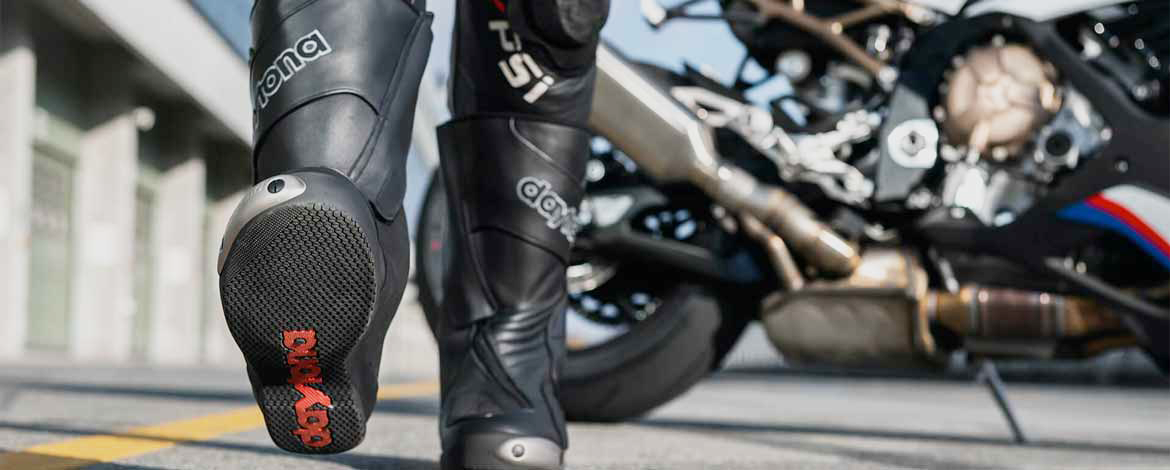
When it comes to motorcycle gear, few items are as crucial—or as often overlooked—as your boots. Motorcycle boots do far more than complete a look; they serve as essential safety gear, offer comfort on long rides, and vary in design depending on your riding style. Whether you're tearing through twisties on a sportbike or cruising along a scenic highway, the right boots can make a big difference.
In this post, we’ll break down the key features of motorcycle boots, their safety functions, how they align with different riding styles, common materials, and how UK and EU sizes compare.
Why Motorcycle Boots Matter.
Your feet, ankles, and lower legs are highly vulnerable in the event of a crash or even a low-speed tip-over. Motorcycle boots are designed to:
Protect against impact and abrasion
Support ankles and prevent twisting injuries
Resist heat from engines and exhaust systems
Provide grip and stability on foot pegs and at stops
They also shield you from the elements—rain, cold, road debris—and can significantly increase your riding confidence.
Key Features of Motorcycle Boots.
Not all motorcycle boots are created equal, but high-quality ones often share these features:
Reinforced Toe and Heel: These areas are most likely to suffer in a crash and need added protection.
Ankle Protection: Armor or padding to guard against impacts and torsion injuries.
Shifter Pad: A dedicated patch to prevent wear from gear shifts.
Oil- and Slip-Resistant Soles: Critical for stable footing at stops and on slick surfaces.
Closure Systems: Zippers, Velcro, buckles, or laces (often combined) for a secure and adjustable fit.
Waterproofing or Ventilation: Depending on climate—look for Gore-Tex or other breathable membranes.
Reflective Elements: Enhances visibility at night.
Choosing the Right Boot for Your Riding Style.
Different styles of motorcycle boots are tailored to different types of riding:
Touring Boots.
Designed for: Long-distance riders and commuters.
Features: Comfort, waterproofing, and good ankle support. Often go higher up the leg for more protection.
Example: Alpinestars Web GTX, Sidi Canyon Gore-Tex.
Sport or Track Boots.
Designed for: Aggressive riding, track days.
Features: Maximum protection with toe sliders, hard armor, and lateral ankle bracing.
Example: Dainese Torque 3 Out, Alpinestars Supertech R.
Cruiser Boots.
Designed for: Classic or cruiser-style bikes.
Features: Sturdy leather, minimal branding, often look like work boots.
Example: Harley-Davidson Riding Boots, TCX Fuel Waterproof.
Adventure / Dual-Sport Boots.
Designed for: On- and off-road riding.
Features: Extra shin and calf protection, waterproofing, rugged soles for walking.
Example: Gaerne SG-12, Forma Adventure.
Urban / Commuter Boots.
Designed for: Daily city riders.
Features: Subtle styling, easy to walk in, blends with casual clothing.
Example: TCX Street Ace WP, REV’IT! Arrow Shoes.
Common Materials in Motorcycle Boots.
Full-Grain Leather: Durable and naturally abrasion-resistant; often used in high-end boots.
Microfiber: A synthetic alternative to leather—lighter and sometimes more breathable.
Thermoplastic Polyurethane (TPU): Used for armor in high-impact areas.
Gore-Tex / Waterproof Liners: Offers breathable waterproofing—essential for all-weather riders.
Rubber Soles: Durable and grippy; may vary in stiffness depending on boot type.
Safety Standards and Certifications.
Look for CE certification when buying motorcycle boots. In the EU and UK, motorcycle gear is classified under the EN 13634 standard:
Level 1: Basic protection
Level 2: Higher level, required for racing or aggressive riding
CE-rated boots are tested for abrasion resistance, impact protection, and sole rigidity.
UK and EU Size Conversion.
Motorcycle boots often come in European sizing, so understanding the conversion to UK sizes is important.
Some manufacturers sizing can vary slightly so it's always worth checking the manufacturers size conversion chart and if possible trying the boots on before you buy:
| UK Size | EU Size |
|---|---|
| 6 | 39 |
| 7 | 40-41 |
| 8 | 42 |
| 9 | 43 |
| 10 | 44-45 |
| 11 | 46 |
| 12 | 47-48 |




